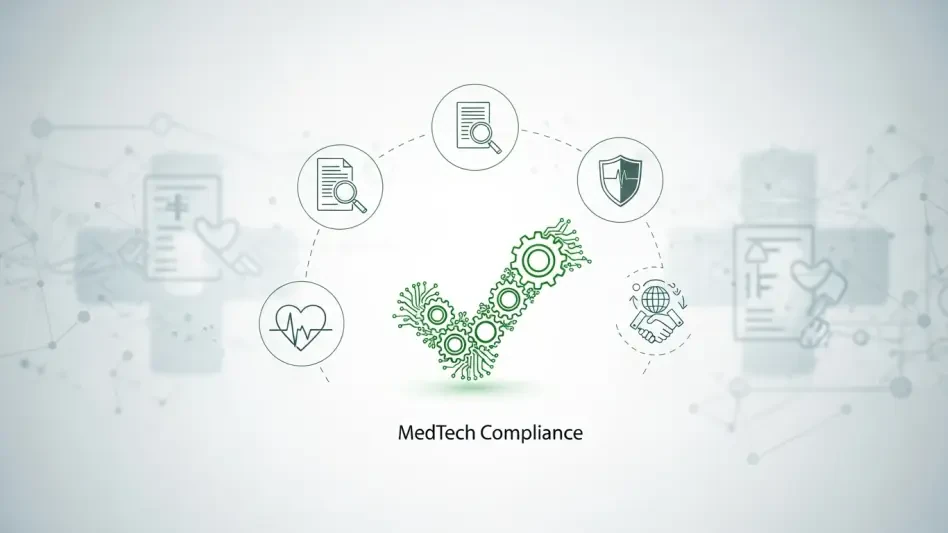Navigating the intricate world of medical technology regulations can feel like a daunting race against time, especially when a groundbreaking device has the potential to save countless lives but remains stalled by compliance hurdles. Imagine a scenario where a cutting-edge diagnostic tool is ready for launch, yet months slip by due to unforeseen regulatory snags, delaying critical patient care. This challenge is all too common in the MedTech industry, where stringent and ever-shifting standards often create bottlenecks. The purpose of this guide is to equip MedTech professionals with actionable strategies to streamline compliance processes, ensuring adherence to complex regulations while accelerating time-to-market. By focusing on practical steps and leveraging modern tools, this resource aims to transform regulatory challenges into opportunities for efficiency.
The stakes in MedTech compliance are extraordinarily high, as regulations are designed to prioritize patient safety above all else. Failing to meet these standards can result in severe penalties, product recalls, or even exclusion from key markets, not to mention the impact on a company’s reputation. This guide offers a roadmap to balance the dual demands of regulatory adherence and operational speed, helping companies bring innovative solutions to patients faster without compromising on quality or safety.
Navigating the Regulatory Maze in MedTech
The MedTech sector operates in a landscape where compliance is not just a legal obligation but a cornerstone of trust and reliability. Regulations are in place to safeguard patients from potential risks associated with medical devices, making adherence non-negotiable. However, the path to compliance is often labyrinthine, with diverse rules across regions and frequent updates that demand constant vigilance. Streamlining this process is essential for companies aiming to minimize delays and maintain a competitive edge in delivering life-changing technologies.
A significant barrier in this journey is the sheer volume of requirements that must be met, often under tight deadlines. The complexity is compounded by the need to align internal processes with external expectations, creating a pressing demand for strategies that simplify adherence. This guide highlights how adopting the right approaches and technologies can turn compliance from a burden into a structured, manageable process.
Beyond just meeting standards, the ultimate goal is to achieve faster market entry without sacrificing quality. By focusing on efficiency, MedTech firms can reduce the time spent on regulatory tasks and redirect resources toward innovation. This section sets the foundation for understanding why streamlined compliance is a critical priority and previews the actionable solutions that follow.
The Growing Complexity of MedTech Regulations
The regulatory environment for MedTech companies has become increasingly intricate, driven by a global push for higher safety and quality standards. Frameworks such as the EU Medical Device Regulation (EU-MDR), the EU In Vitro Diagnostic Regulation (EU-IVDR), and the FDA guidelines in the United States impose rigorous demands on documentation, testing, and traceability. These rules are vital for ensuring that devices perform as intended and pose minimal risk to users, but they also create significant challenges for manufacturers striving to keep pace.
Adding to this complexity are emerging regulations that extend beyond traditional safety concerns. The EU AI Act, for instance, introduces strict governance for artificial intelligence used in medical technologies, while the Corporate Sustainability Reporting Directive (CSRD) mandates detailed environmental impact disclosures. Such developments reflect a broader shift toward accountability, requiring companies to adapt to a wider scope of compliance obligations that influence not just product design but also corporate practices.
The dynamic nature of these regulations underscores the urgency for adaptive strategies. With updates occurring frequently and varying by region, MedTech firms must stay ahead of changes to avoid costly delays or non-compliance penalties. Understanding this evolving landscape is the first step toward building a robust framework that ensures both regulatory alignment and the ability to innovate in a competitive global market.
Key Steps to Streamline Compliance for Market Speed
Step 1: Assessing Regulatory Requirements Across Regions
The foundation of effective compliance lies in a thorough assessment of regulatory demands specific to each target market. Early in the product lifecycle, it is critical to map out the standards that apply, whether launching in North America, Europe, or other regions. This proactive approach helps identify potential obstacles before they become roadblocks, enabling smoother development and approval processes.
Identifying Regional Variations
Divergent standards across geographies can create significant compliance gaps if not addressed early. For instance, while the FDA emphasizes pre-market approvals in the U.S., the EU-MDR focuses heavily on post-market surveillance and clinical evaluations. Conducting a detailed comparison of these requirements ensures that product designs and documentation meet the strictest criteria from the outset, reducing the need for costly revisions later.
Planning for Emerging Frameworks
Beyond existing rules, anticipating new regulations is equally important. With frameworks like the EU AI Act and sustainability reporting gaining traction, companies must integrate forward-looking strategies into their planning. Staying informed about legislative developments from the current year to 2027, for example, allows for the incorporation of future requirements into current workflows, minimizing disruptions when new laws take effect.
Step 2: Adopting Digital Tools for Lifecycle Management
Technology plays a pivotal role in simplifying the compliance journey by providing structured solutions for managing vast amounts of data and documentation. Digital platforms can automate repetitive tasks, ensuring accuracy and freeing up valuable time for strategic priorities. This step focuses on integrating such tools to oversee the entire product lifecycle with greater precision.
Ensuring Traceability with ALM Systems
Application Lifecycle Management (ALM) systems are indispensable for maintaining traceability, a key regulatory requirement. These tools automate the tracking of design changes, testing results, and other critical data, ensuring that all documentation is audit-ready at any moment. By reducing manual effort, ALM systems help teams demonstrate compliance swiftly during regulatory reviews.
Optimizing Data with PLM Platforms
Product Lifecycle Management (PLM) platforms offer a centralized repository for all product-related information, enhancing consistency across development stages. By consolidating data from design to manufacturing, these systems minimize errors and streamline communication between departments. The result is a more cohesive approach to meeting regulatory standards while maintaining efficiency.
Step 3: Fostering Cross-Departmental Collaboration
Compliance is not the responsibility of a single team but requires coordinated efforts across an organization. Siloed operations can lead to miscommunication and delays, making integration a vital component of streamlined processes. This step explores how to build a unified approach to regulatory challenges.
Breaking Down Silos for Faster Response
Effective communication between engineering, quality assurance, and regulatory affairs teams is essential for rapid response to updates or issues. Establishing regular cross-functional meetings and shared digital dashboards can ensure that all stakeholders are aligned on compliance goals. Such collaboration enables quicker identification and resolution of potential roadblocks.
Aligning Goals for Compliance and Innovation
Balancing regulatory demands with the drive for innovation requires a shared vision across departments. By setting common objectives, teams can prioritize both adherence to standards and the development of cutting-edge solutions. This alignment ensures that compliance efforts support rather than hinder the creation of transformative medical technologies.
Step 4: Automating Compliance Checks and Risk Management
Manual processes are prone to errors and inefficiencies, often prolonging the time needed for regulatory approvals. Automation offers a reliable way to conduct compliance checks and manage risks proactively. This step delves into how technology can minimize human error and protect market entry timelines.
Reducing Audit Times with Automation
Automated tools can transform audit preparation by generating real-time reports and maintaining up-to-date records. What once took weeks—compiling documentation and verifying data—can now be accomplished in minutes, significantly speeding up the review process. This efficiency allows companies to focus on core activities rather than administrative burdens.
Mitigating Risks with Predictive Insights
Advanced technologies can analyze historical data to predict potential compliance issues before they arise. By identifying risks early, such as design flaws or documentation gaps, firms can take corrective actions without derailing schedules. This proactive approach safeguards against delays and ensures smoother regulatory interactions.
Step 5: Enhancing Post-Market Surveillance and Service
Compliance does not end at market entry; ongoing monitoring is crucial to maintain standards and ensure patient safety. Post-market surveillance provides valuable insights into device performance and user feedback. This step focuses on leveraging digital solutions to optimize these efforts.
Leveraging Predictive Maintenance
Digital tools equipped with predictive analytics can anticipate device malfunctions or maintenance needs before they impact users. By addressing issues preemptively, companies can uphold compliance with safety regulations and prevent costly recalls. This capability enhances trust in the product’s reliability over its lifecycle.
Streamlining Feedback Loops
Real-time data collection from end-users and healthcare providers enables rapid identification of performance trends or concerns. Streamlined feedback mechanisms ensure that this information is quickly integrated into regulatory reporting and product updates. Such agility helps maintain compliance while continuously improving device efficacy.
Summarizing the Path to Efficient Compliance
The journey to streamlined MedTech compliance hinges on a series of well-defined steps that collectively accelerate market entry while upholding rigorous standards. These include:
- Assessing and mapping regional and emerging regulatory requirements to avoid unexpected hurdles.
- Adopting ALM and PLM systems to ensure traceability and centralized data management for seamless audits.
- Fostering collaboration across departments to create a unified front for addressing compliance challenges.
- Automating compliance checks and risk management to eliminate errors and reduce preparation times.
- Enhancing post-market surveillance with predictive and real-time tools to sustain adherence and safety.
These strategies work in tandem to create a robust framework that prioritizes efficiency. By implementing them, MedTech companies can navigate regulatory demands with confidence and speed.
Broader Implications and Future Trends in MedTech Compliance
The approaches outlined in this guide align closely with overarching trends shaping the MedTech industry, particularly the rapid push toward digital transformation. As regulations expand to cover areas like AI governance and sustainability, the reliance on technology to manage compliance becomes even more pronounced. This shift signals a future where manual processes are largely obsolete, replaced by integrated systems that handle multifaceted requirements.
Looking ahead, the scope of compliance is expected to broaden further, encompassing stricter global standards and ethical considerations. Continuous training and technology integration will be essential to keep pace with these changes. Companies that invest in upskilling their teams and adopting scalable solutions now will be better positioned to adapt to evolving expectations over the coming years.
Moreover, streamlined compliance offers a competitive advantage by freeing up resources for innovation. As digital tools become more sophisticated, incorporating advanced analytics and machine learning, the potential to anticipate regulatory shifts grows. Embracing these advancements positions MedTech firms not just to meet current demands but to lead in a landscape defined by rapid change and heightened accountability.
Taking Action for Faster, Compliant Market Entry
Reflecting on the journey through regulatory challenges, it becomes evident that streamlined compliance has transformed from a daunting obstacle into a structured pathway for MedTech companies. The steps taken—assessing diverse requirements, adopting digital tools, fostering collaboration, automating processes, and enhancing surveillance—have proven instrumental in balancing adherence with speed. These efforts have paved the way for safer, innovative devices to reach patients sooner.
Moving forward, the focus should shift to sustained improvement and proactive adaptation. Companies are encouraged to regularly evaluate their compliance frameworks, identifying gaps where new technologies or training could further optimize outcomes. Building partnerships with regulatory experts or investing in scalable digital platforms can also provide a strategic edge.
Ultimately, the commitment to embracing technology as a cornerstone of compliance has not only ensured regulatory success but also elevated patient care standards. The next step lies in deepening this integration, exploring emerging tools, and maintaining a forward-thinking mindset to stay ahead of regulatory curves. This ongoing dedication promises not just market success but a lasting impact on global health outcomes.









